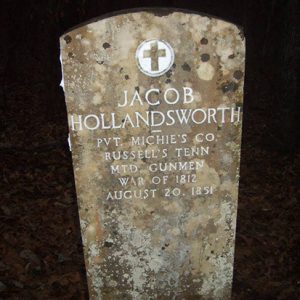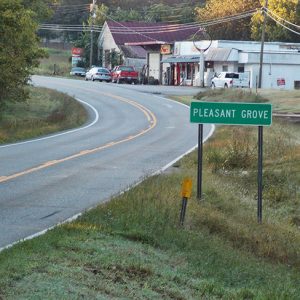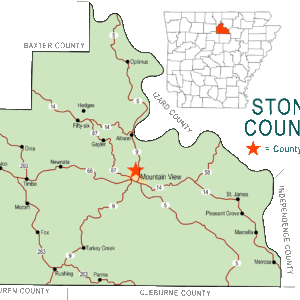calsfoundation@cals.org
Pleasant Grove (Stone County)
aka: Redstripe (Stone County)
The community of Pleasant Grove is located along Highway 14 about twelve miles east-southeast of Mountain View (Stone County), the county seat. Pleasant Grove is between Marcella (Stone County) and St. James (Stone County). The White River lies just over two miles to the east, accessible via the Martin Public Access. What is left of the old Hess/O’Neal/Grigsby Ferry is used by a local farmer to transport goods across the river. Pleasant Grove was originally known as Red Stripe, but the name of the community changed its name following the infamous Connie Franklin murder case.
One of the first settlers of Red Stripe was a veteran of the War of 1812, Jacob Hollandsworth from Virginia by way of Tennessee. He married Lydia Fuson in Tennessee in 1817. Hollandsworth and his growing family, which eventually consisted of eight girls and two boys, ended up in Shaved Navel (a.k.a. Buck Horn and later St. James) shortly after 1840 to farm along the White River across from Penters Bluff (Izard County). They grew grain crops such as corn, which was sometimes used in the area for the lucrative but risky moonshine business. He also had livestock, including cattle and horses.
Hollandsworth died in August 1851 and is buried next to his wife in the Hollandsworth Cemetery on their old farm. His gravestone has a War of 1812 military marker, but his wife’s tombstone is now broken and scattered. Their ten children married into several of the pioneer families of the area, including the Younger family of St. James.
Red Stripe was in Independence County until April 17, 1873, when Stone County was created. The community was part of what is now St. James during the early days of settlement. There are a few different versions of why the name Red Stripe was chosen for the post office and community, the most logical one relating to the iron ore in the soil, which made the dirt appear striped with red. The Red Stripe post office was established on August 28, 1912, with Mable Estes Blair appointed postmaster.
The infamous Connie Franklin murder case began in the spring of 1929 when Franklin was allegedly murdered near St. James and Red Stripe by four men of the communities. Details remain sketchy. Franklin had recently arrived in St. James and started seeing a young woman of the community. Allegedly, the men waylaid the couple, sexually assaulted the woman, tortured and killed Franklin, and then burned his corpse. However, the case took a strange turn when, during the trial, a man claiming to be the murder victim, Connie Franklin, walked into the courtroom, resulting in a not-guilty verdict for the accused men. Many said it was an imposter, a trick by the defense; some alleged it was really Connie Franklin and the defendants had been framed. Still others told the media it was the ghost of Connie Franklin. The apparent Connie Franklin died three years later of appendicitis.
Red Stripe’s name was officially changed to Pleasant Grove in February 1930 due to the adverse publicity from the trial. The post office was in the general store owned and operated by postmaster Mary M. Daum Logan and her husband, Odus Maxie Logan; Mary and Odus Logan are buried in Pleasant Grove Cemetery. The store has been owned and operated by Danny Jackson and his family since 1985, but the post office was moved to a lone building along Highway 14 near the store. The Jackson General Store is one of the few of its kind left in Stone County.
In 1949, under Arkansas Act No. 1, a new school district was formed called Stone County School District No. 1, which included every district in the county except Mountain View. A county superintendent began overseeing the newly formed school centers: Rural Special (at Fox), Timbo, Fifty-Six, and Pleasant Grove. The old school at Pleasant Grove also served the children of St. James until consolidation with the Mountain View’s school system around 1970. The school taught grades 1–12 and had a basketball team. The school building later served as a church and then was renovated into a family dwelling.
For additional information:
Blevins, Brooks. Ghost of the Ozarks: Murder and Memory in the Upland South. Urbana: University of Illinois Press, 2012.
Rushing, Phillip. “Early History of Rural Springs School.” Heritage of Stone 4 (Fall 1980): 27-30.
“Stone County Post Offices.” Heritage of Stone County 2 (1978): 2–22.
Kenneth Rorie
Van Buren, Arkansas
 Hollandsworth Tombstone
Hollandsworth Tombstone  Jackson General Store
Jackson General Store  Penters Bluff
Penters Bluff  Pleasant Grove Post Office
Pleasant Grove Post Office  Pleasant Grove
Pleasant Grove  Stone County Map
Stone County Map 




Some people say that the Younger family member who married one of Jacob Hollandsworth’s daughters was descended from the outlaw Younger brothers. I believe that would be an impossibility given that John William Younger, who married Rebecca Hollandsworth Smith, was born in 1829. I do not know if they are related to the other Younger family. I do know that John William Younger lived in Tennessee, and he and Rebecca had both been widowed prior to their marriage. They married December 21, 1854, in Independence County, Arkansas. They lived in Tennessee and are both buried at Oakwood Cemetery in Milan, Tennessee. Other families that the Hollandsworth children married into were McElmurry, Collom, Massey, Ford, and Lancaster.